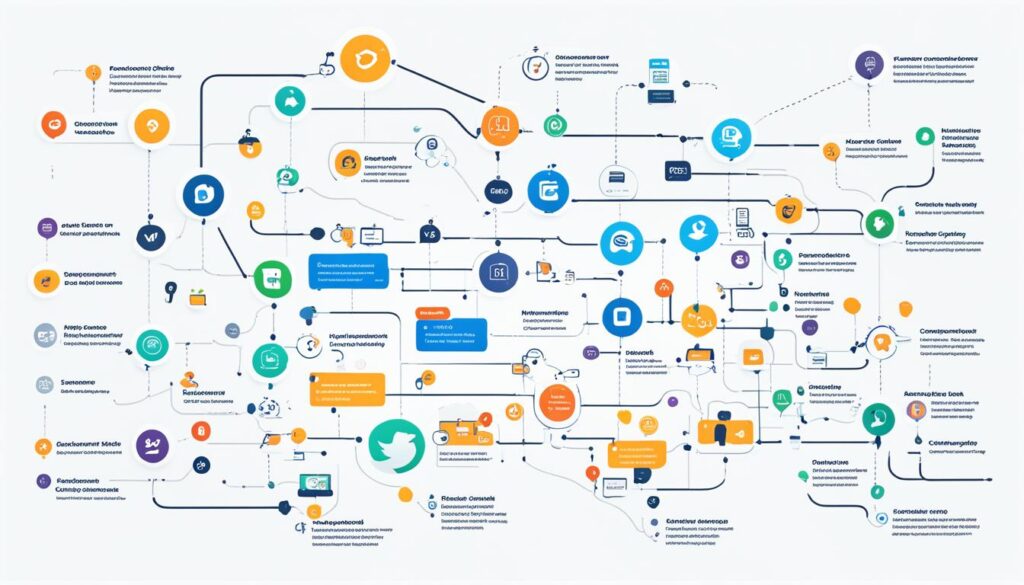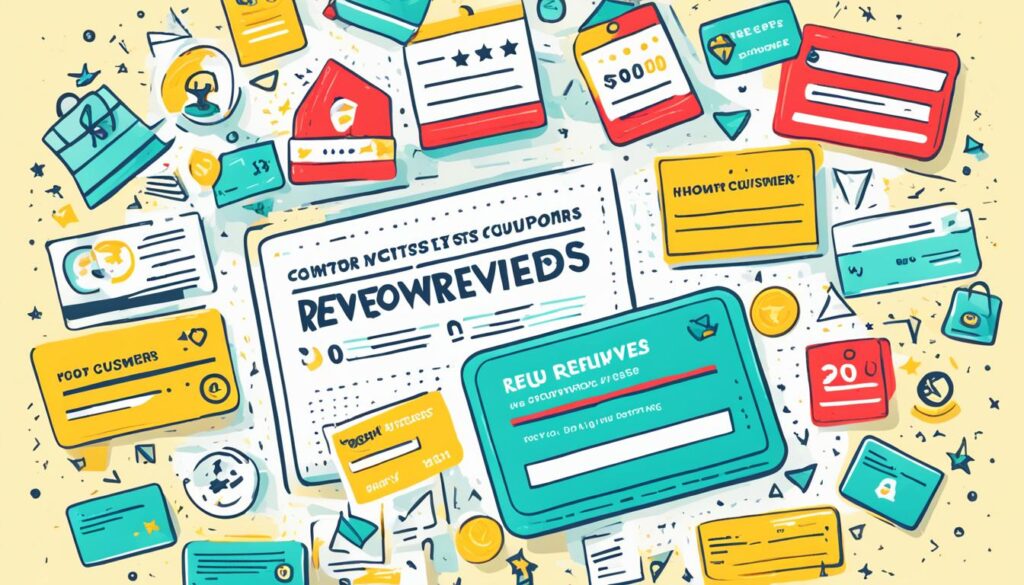Ever wondered why some businesses get lots of great reviews while others don’t get any? It’s all about how well they follow up. In today’s world, customer reviews are super important. But, many companies don’t use follow-ups well to get the feedback they need.
Let’s explore how to improve your review follow-ups. With the right methods, you can get more customer interaction and make the most of online reviews. This can help your business grow.
Did you know 44 percent of salespeople give up after just one follow-up call? This shows a big missed chance. With eight follow-up calls on average, we could get more customer feedback and boost response rates.
In retail, about 20-30% of people answer surveys. For B2B, it’s 10-20%1. These numbers show how important it is to make our follow-ups better. By using different ways to communicate and making our messages personal, we can beat these averages and get great results.
Key Takeaways
- Strategic follow-ups are crucial for maximizing review responses
- Persistence is key: most prospects say “no” four times before saying “yes”
- Multi-channel communication enhances engagement
- Personalization significantly improves response rates
- Mobile optimization leads to faster survey completion
- Timing and consistency are vital for successful follow-ups
Understanding the Importance of Review Follow-Ups
Review follow-ups are key to a strong online reputation and business growth. They help build trust by showing off happy customers. In fact, 83% of people trust what others say more than any ad2.
Regular follow-ups can get more reviews, which helps with search rankings. People usually read 7 reviews before they trust a business2. A good follow-up plan helps us keep customers happy and make better products.
Follow-ups do more than just get reviews. In sales, it often takes 5 follow-up calls to close a deal3. This shows we need to keep following up, whether for reviews or sales.
| Follow-up Benefits | Impact |
|---|---|
| Customer Retention | More cost-effective than getting new customers |
| Competitive Advantage | Sets business apart from others |
| Sales Opportunities | Leads to selling more and introducing new products |
| Customer Satisfaction | Helps find ways to get better |
To make our review follow-ups work best, we should send 4 to 9 follow-up emails. This can really increase how many people respond4. Finding the right balance helps us look good online without bothering our customers too much.
Timing Your Follow-Up Messages for Maximum Impact
Sending follow-up messages at the right time can really help boost your email open rates and how quickly people respond. Timing is key for getting customers engaged and making your follow-up plan better.
Our studies suggest sending your first follow-up 24-48 hours after a meeting or chat. This shows you’re proactive and keeps the conversation alive5. For events, try to follow up within a week to keep the connection strong5.

For sales pitches, give prospects a few days to look over your proposal before you follow up. This lets them think it over and also makes them feel a bit rushed5. Interestingly, Tuesdays at 6 a.m. are the best time to send emails6.
To make your follow-up plan better, keep these tips in mind:
- Wait 2-3 days before sending your first follow-up email
- Slowly increase the time between each follow-up
- Plan for 6 touchpoints, starting with the first email
- Use personalized greetings to be friendly
About 90% of people open and reply to emails on the day they get them. This makes waiting 2-3 days before the first follow-up very important for a big impact6. By planning your follow-ups well and understanding how customers behave, you can really improve how well you engage with them.
To see how well your timing works, watch the open rates, response rates, and conversion rates of your follow-up emails. These numbers tell you a lot about how engaged people are and how well your follow-ups are doing5. Always ask for feedback from your customers. It’s a great way to make your approach better and get better results.
Crafting Compelling Follow-Up Messages
Making follow-up messages engaging is key to getting more reviews. We’ll look at strategies to make email templates that get customers involved and bring better results.

Adding a personal touch to follow-up emails can really stand out. Messages that feel personal are more likely to stick with people and get a response. This helps build a stronger bond with your audience7. By mentioning past chats or shared interests, you make your message clearer and boost response rates7.
Subject lines are super important for getting people to open your emails. Adding specific numbers and times can really help7. Saying “tomorrow” in the subject line can make people more likely to open it by 10%7. A HubSpot study showed that emails without subject lines got opened 8% more than those with one7.
When writing your message, keep it clear. Start by giving some background to help people understand and respond better7. Be clear about why you’re following up to make people more likely to answer7. A simple approach helps avoid your email being seen as spam or confusing7.
Make sure your email has a strong call-to-action (CTA) to tell people what to do next8. Show how your product or service adds value and explain its benefits clearly8. Keep your tone professional and polite throughout8.
| Follow-Up Email Component | Best Practice |
|---|---|
| Subject Line | Short, detailed, and engaging |
| Greeting | Polite with context |
| Content | Clear purpose and customer engagement |
| Call-to-Action | Compelling and specific |
By using these tips, you can make follow-up messages that connect with your audience and get results. Don’t forget to try different ways and improve your email templates based on what works best7.
Leveraging Multiple Communication Channels
Today, customers interact with brands on many platforms. Using an omnichannel approach helps reach your audience well. SMS marketing, social media, phone calls, and direct mail cater to different customer likes.
Email is still popular, but SMS marketing gets quick replies. Social media reaches a lot of people, and phone calls add a personal feel. Don’t forget about direct mail – it can be a standout in our digital world.

To boost engagement, try using surveys after interactions via email or text9. Offering small rewards for surveys can increase participation9. QR codes in real places can also help get more survey answers9.
Use analytics to track engagement across channels and improve your strategy10. Automation can make sending messages easier, like event-triggered ones10. Personalize content and adjust your approach for different customer groups for better outcomes10.
| Channel | Advantage | Best Practice |
|---|---|---|
| SMS Marketing | Quick responses | Keep messages concise |
| Social Media | Broad reach | Monitor brand mentions9 |
| Phone Calls | Personal touch | Use for high-value customers |
| Direct Mail | Stands out | Include compelling visuals |
By using various channels and customizing your approach, you can make a strong follow-up plan. This plan will connect with your audience and help you achieve your goals.
Personalization Techniques to Increase Engagement
Personalizing your review request follow-ups can really boost engagement. By using customer data and segmenting, we make content that speaks to each person. This makes the customer journey better and gets more responses.
Using behavioral targeting lets us send messages that match what customers do. For example, we can email customers who have used certain services recently. This makes our requests more relevant and timely11. This way, we can increase email open rates by 26%, showing it works well in grabbing attention11.
To make these personalization techniques work, think about these strategies:
- Create detailed customer personas for different segments
- Use integrations like Listrak or Remarkety to add social proof in emails
- Implement AI-powered tools like Klaviyo for better segmentation and targeting
- Set up behavior-triggered email automation for timely follow-ups
By making our messages fit each person and their actions, we make the experience more engaging and personal. This not only helps our review requests do better but also builds stronger customer relationships.
| Personalization Technique | Impact |
|---|---|
| Personalized subject lines | 26% increase in open rates11 |
| User-generated content in emails | Up to 161% boost in conversion rates12 |
| Email marketing ROI | $36 for every $1 spent11 |
The secret to great personalization is balancing customer data with being real. By doing this, we can offer personalized advice that feels real and valuable. This leads to better engagement and more reviews.
Incentivizing Responses Without Compromising Authenticity
We know how powerful customer incentives can be in getting more reviews. Using loyalty programs can really help increase reviews and keep them real13. Giving out discounts or free shipping can make customers want to give their feedback more.
It’s important to use ethical ways to encourage reviews. We suggest giving out rewards that don’t make people feel like they have to say only good things. Things like loyalty points or special content can make customers want to share their thoughts without feeling forced.

To keep reviews real, we focus on the importance of honest feedback. This way, we follow the rules and keep the review process honest14. Remember, paying people for reviews is not a good idea because it can make people lose trust and get in trouble with review sites.
Showing customers we care is a big part of our plan. We thank everyone for their feedback, whether it’s good or bad. This makes people more likely to leave reviews and makes the feedback we get even more useful.
| Incentive Type | Impact on Review Authenticity | Customer Engagement |
|---|---|---|
| Loyalty Points | High | Moderate |
| Exclusive Content | High | High |
| Discount Coupons | Moderate | Very High |
| Free Shipping | Moderate | High |
By finding the right balance between rewards and listening to customers, we all win. Customers feel important, and we get real, helpful feedback to make our products better.
Review Request Follow-Up Tactics That Drive Results
Following up with customers is key to getting more reviews and making customers happier. We use a planned way to manage reviews, which really helps get more responses. Automation tools help us send out messages at the right times, making sure our requests are clear and urgent.
Our studies show that 76% of customers leave reviews when asked, showing how important it is to ask them15. Text messages work great too, with over 97% of people opening them quickly16. This makes SMS a top choice for sending review requests and following up.
We keep checking and tweaking our approach to get better results. Testing different messages and times helps us make sure our requests hit the mark. We’ve made leaving reviews part of how we talk to customers, making it easy for them to give feedback.
| Follow-Up Tactic | Impact |
|---|---|
| Systematic Follow-Up Process | Increased response rates |
| Automation Tools | Streamlined workflow |
| Text Message Requests | 97% open rate within 4 minutes |
| A/B Testing | Optimized message content and timing |
Using these strategies has really helped us get more reviews. Remember, 98% of people check out online reviews for local businesses15. With hard work and making things better, these tactics can really help your business.
Conclusion: Maximizing Review Responses Through Strategic Follow-Ups
We’ve seen how strategic follow-ups can boost review responses and improve our online reputation. By fine-tuning our review strategy, we can help our business grow and focus on our customers. Timing is crucial. Sending a first follow-up email within 24 hours shows we’re professional. Following up in 48-72 hours after a proposal keeps the conversation alive1718.
Personalizing our approach is key in managing customer feedback. Using the prospect’s name and referencing past talks makes our follow-ups more impactful18. It’s important to find the right balance between being persistent and respecting our customers’ wishes. Too many messages can hurt our chances of getting a response17.
To make things easier, we can use technology like CRM systems. These tools help us keep track of contacts, automate follow-ups, and monitor how well we’re doing17. By regularly checking and tweaking our follow-up plans based on what we learn, we can make our process better and get better results18. Our main aim isn’t just to get more reviews. It’s to build stronger relationships with customers and use their feedback to improve our business.
FAQ
Why are review follow-ups important for businesses?
What factors should be considered for effective follow-up timing?
How can businesses create compelling follow-up messages?
What communication channels should businesses use for follow-ups?
How can businesses personalize follow-up messages effectively?
Should businesses offer incentives for review responses?
How can businesses streamline their follow-up process?
Source Links
- How to increase survey response rates: 20+ proven tips – https://www.asknicely.com/blog/how-to-increase-survey-response-rates
- Why You Need Customer Reviews (and the Best Ways to Get Them) | Mailchimp – https://mailchimp.com/resources/why-you-need-customer-reviews-and-the-best-ways-to-get-them/
- 9 Reasons Why Following-Up with Customers Matters. – https://www.linkedin.com/pulse/9-reasons-why-following-up-customers-matters-sanee-sunny-shinde
- The Role of Follow-Up Emails in Email Marketing Strategy: Effective Templates for Different Cases – GlockApps – https://glockapps.com/blog/the-role-of-follow-up-emails-in-email-marketing-strategy-effective-templates-for-different-cases/
- Crafting the Perfect Follow-Up Email – https://www.salesforge.ai/blog/from-inbox-to-response-crafting-the-perfect-follow-up-email
- How To Write a Sales Follow-up Email After No Response [10 Templates] – https://mailshake.com/blog/follow-up-email-strategy/
- The Ultimate Guide On How To Write A Follow Up Email – https://www.hubspot.com/sales/follow-up-email
- Sales Follow Up Email: Templates, Subject Line & Examples – https://optinmonster.com/sales-follow-up-emails-boost-customer-loyalty/
- The Art of Asking the Right Customer Feedback Questions – Affinitiv – https://www.affinitiv.com/blog/4-ways-to-get-more-automotive-customer-feedback/
- Leveraging Multiple Communication Channels – FasterCapital – https://fastercapital.com/topics/leveraging-multiple-communication-channels.html/2
- Email personalization techniques beyond ‘Dear [Name]’ – https://funnel.io/blog/beyond-dear-name-email-personalization-techniques
- 4 Email Engagement Strategies and Tools for Personalization | Yotpo – https://www.yotpo.com/blog/4-email-engagement-strategies-and-tools-for-personalization/
- How to Encourage More Reviews from Customers – https://www.helpdesk.com/learn/how-to-encourage-more-reviews-from-customers/
- How to Ask for a Review: Expert Tactics & Templates – https://getflowbox.com/blog/how-to-ask-for-a-review/
- How to Ask for Reviews (With Examples & Templates!) – https://www.wordstream.com/blog/ws/2020/07/16/how-to-ask-for-reviews
- 15 Strategies to Increase and Get More Google Reviews – https://www.widewail.com/blog/strategies-to-get-more-reviews
- 5 Effective Follow-up Strategies to Maximize Success – https://www.convolo.ai/blog/5-effective-follow-up-strategies-to-maximize-success
- Mastering Follow-Up Strategies to Maximize Sales Success – https://www.criya.co/article/mastering-follow-up-strategies-to-maximize-sales-success

